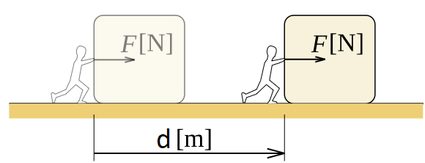how to find work physics
Welcome to the work calculator, where you can learn the work formula, and how to calculate work. For physicists, work is a very different concept than in normal life, there's even a work equation!
Come in to read about the work definition, and what are SI units for work. It might seem complicated, but I promise it won't be much "work".
If you came here to calculate work done by gases, then our combined gas law calculator is the tool you are looking for.
Work definition in physics and work formula
In our everyday life, work is any kind of effort, job, or action that we perform. Work in physics, however, has a very strict and clear definition. As it happens normally, the work definition in physics is almost the same as the work equation.

In physics, to have work we need an object to move as a result of a force applied to it. The work equation (or the work definition if you will) is:
W = F * d
where,
-
Wis the work done; -
Fis the force applied to the object; and -
dis the distance about which you moved the object.
The force can be decomposed like this:
F = m * a
where,
-
mis the mass of the object; and -
athe acceleration it experiences.
Remember that when the object is being lifted at a constant speed (a typical school problem), the acceleration on the object is g (the gravitational force).
Work and power are two related concepts, you can calculate the power (P) from the work done if you know the time (t) that it took to do such work. Simply use the equation:
P = W / t
Work from velocity change
If we want to go down the rabbit hole, we can use any force formula we want. Then substitute the value into the work equation, and get the result. Other times, that might be an unnecessary step.
Consider an object that changes its speed from an initial velocity (v0 ) to a final velocity (v1 ) over a time (t). We could calculate the force using the acceleration:
F = m * a = m * (v1 - v0) / t
then we obtain the distance traveled that can be estimated as:
d = t * (v0 + v1) / 2
and then combine everything into the work formula:
W = F * d = [m * (v1 - v0) / t] * [t * (v0 + v1) / 2]
W = (m/2) * (v1 2 - v0 2)
SI units of work in physics
There are many instances in which the units used in real-life don't match the units used in physics, but work is not one of those... kind of. If you look at the work formula, you can see that the units are [Newtons]*[meters] for the SI system. The SI units of work are, therefore, Joules.
Joules (and calories) are typically called units of energy, but energy and work use the same units, as they are very similar concepts in physics.
Work equation - how to calculate work?
If all you came here for is learn how to calculate work, this is your section. You are doubly lucky since the calculation is fairly simple, as you might have guessed from the work formula.
All you need to do is take the force, F, and multiply it by the distance the object moved. The result will be the work performed on the object.
If you want to get fancy/advanced, you can include the force definition into the work equation and obtain:
W = m * a * d
which is still a simple multiplication that can be done quickly. Too much work for you? Don't fret! Our calculator will tell you exactly how much work has been done in your scenario, so you can save that precious brainpower.
How to use the work calculator?
The work calculator is very simple to use. In its basic form, you simply need to input the force and the distance from your scenario, and it will automatically calculate the result for you.
If you are an adventurous person, you can use the advanced mode to get to more... advanced calculations and alternative modes.
When you enter this mode, you will see 3 different sections that will allow you to calculate:
- Calculate work from mass, initial velocity, and final velocity;
- Calculate work from Force and distance;
- Calculate Force from mass and acceleration;
- Calculate Acceleration from initial velocity, final velocity and time;
- Calculate Power from work and time; and...
- Many more!
This work calculator is smart. All you need to do is input the values you know and it will do calculate the work and all other possible values for you!
Álvaro Díez

how to find work physics
Source: https://www.omnicalculator.com/physics/work
Posted by: huffmanancomp.blogspot.com

0 Response to "how to find work physics"
Post a Comment